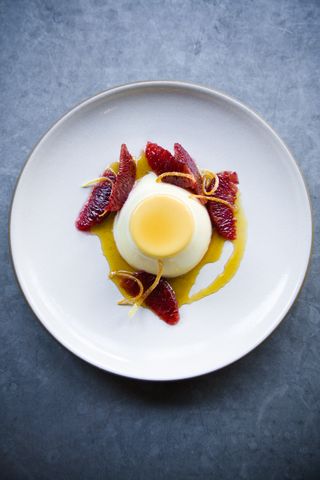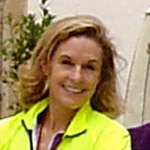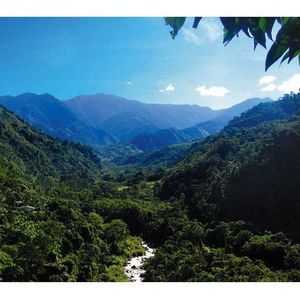 Most people who visit Costa Rica head for the water… the surfing, beachcombing, kayaking and deep-sea fishing are first-rate. But this week I headed for the hills.
Most people who visit Costa Rica head for the water… the surfing, beachcombing, kayaking and deep-sea fishing are first-rate. But this week I headed for the hills.
My husband and I come to Costa Rica almost every year to spend time with relatives in their home on the beach between Quepos and the Manuel Antonio National Park. Typically we do nothing, or next to nothing. A little kayaking, walks on the beach, a lot of reading, and naps galore.
But on Thursday we found ourselves in the Chirripo Valley (pictured here), the start of the Chirripo National Park, a remote, end-of-the-road kind of place with vertical walls of dense vegetation, a boulder-strewn, rushing river, and a rolling valley floor dotted with hardscrabble farms. It was there I met and fell in love with Rosita.
We were on a tour of Quesos Canaan (Canaan Cheese Co.), arranged by Carlos Rojas and Randy Langendorfer, proprietors of Monte Azul, the eco-lodge where we spent the night. (More about this magical getaway in my next post.)
Randy and my sister-in-law translated as owner/cheesemaker Wilberth Mata showed us around the sustainable farm (he uses cow manure to make the methane gas that fuels the operation), and led us, step by precise step, through the cheese-making process.
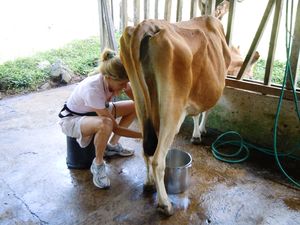 And, since that process starts with milk, duh, we were soon introduced to Rosita, an 18-year-old cow with a tangle of protruding ribs but a gentle personality and “protected” status because of her long years of service.
And, since that process starts with milk, duh, we were soon introduced to Rosita, an 18-year-old cow with a tangle of protruding ribs but a gentle personality and “protected” status because of her long years of service.
I wish I had captured the facial expressions of our city-slicker group as Wilberth demonstrated the fine art of milking, then told us each to take a turn. Later, when he squirted Rosita’s milk directly into a mug for us to drink, the “what the…what the..?" faces returned. But, the warm, rich and super-frothy milk was delicious and cried out for a shot of espresso.
Back in the tiny, spotless cheese-making room, we inoculated milk with lacto-bacillus and rennet, listened to Wilberth’s story of how he learned to make cheese 10 years ago from a visiting Swiss gent, who subsequently invited him to spend a few weeks in Switzerland (it was his first plane ride and only time ever out of Costa Rica); and eventually “cut the cheese, “ using a special rake-like tool to cut through the curds which had separated from the whey. (Read more about the family’s fascinating story in a Tico Times article.)
We added salt, stirred and stirred, heated the mixture to exactly 38 degrees C., stirred some more, then watched the slim but remarkably strong Wilberth lift the 125-pound kettle with the ease he’d hoist a frisky toddler, and pour off the opaque whey. (The handsome farmer, somewhere in his early 40s, is an accomplished runner, with multiple shelves of trophies for his performance in the annual International Chirripo Marathon, a gnarly mountain foot race that covers 8,000 vertical feet before reaching the top of Mt. Chirripo, Costa Rica’s highest peak. Wilburth is a perennial winner, running it, round-trip, in just over three hours.)
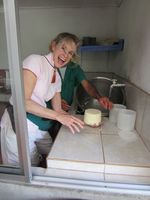 Wilberth Mata operates Quesos Canaan with his wife and partner Kattia Hernandez and additional help from their three kids. The Tipo Suizo cheese, which is dense and dotted with tiny “holes,” has a mild but distinctive buttery, nutty flavor (as opposed to most Costa Rican cheeses which, in my opinion, have no flavor at all). It’s sold in some restaurants and stores in Manuel Antonio and San Jose, but most of it doesn’t leave the insulated Chirripo Valley. The Mata Hernandez clan makes just nine pounds of cheese a day, every day of the year. Do the math.
Wilberth Mata operates Quesos Canaan with his wife and partner Kattia Hernandez and additional help from their three kids. The Tipo Suizo cheese, which is dense and dotted with tiny “holes,” has a mild but distinctive buttery, nutty flavor (as opposed to most Costa Rican cheeses which, in my opinion, have no flavor at all). It’s sold in some restaurants and stores in Manuel Antonio and San Jose, but most of it doesn’t leave the insulated Chirripo Valley. The Mata Hernandez clan makes just nine pounds of cheese a day, every day of the year. Do the math.
We were lucky enough to be the creators of the nine pounds (four hefty wheels) created on Friday, and now perched on a shelf in the Quesos Canaan aging room. Some day, after the minimum three-month aging period, a lucky cheese-lover will cut into and enjoy the cheese made, with love, by Rosita and me.
A Website for Quesos Canaan is under construction. You can email the Mata Hernandez family at: quesoscanaan@hotmail.com. Visitors are welcome; the formal tour-and-cheese-making gig lasts three to four hours and costs about $40 a person.
